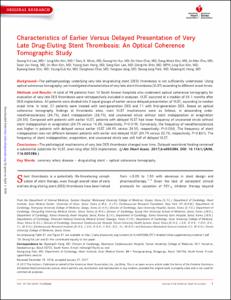KUMEL Repository
1. Journal Papers (연구논문)
1. School of Medicine (의과대학)
Dept. of Internal Medicine (내과학)
Characteristics of Earlier Versus Delayed Presentation of Very Late Drug-Eluting Stent Thrombosis: An Optical Coherence Tomographic Study
- Keimyung Author(s)
- Hur, Seung Ho
- Department
- Dept. of Internal Medicine (내과학)
- Journal Title
- Journal of the American Heart Association
- Issued Date
- 2017
- Volume
- 6
- Issue
- 4
- Abstract
- Background-—The pathophysiology underlying very late drug-eluting stent (DES) thrombosis is not sufficiently understood. Using
optical coherence tomography, we investigated characteristics of very late stent thrombosis (VLST) according to different onset times.
Methods and Results-—A total of 98 patients from 10 South Korean hospitals who underwent optical coherence tomography for
evaluation of very late DES thrombosis were retrospectively included in analyses. VLST occurred at a median of 55.1 months after
DES implantation. All patients were divided into 2 equal groups of earlier versus delayed presentation of VLST, according to median
onset time. In total, 27 patients were treated with next-generation DES and 71 with first-generation DES. Based on optical
coherence tomography findings at thrombotic sites, main VLST mechanisms were as follows, in descending order:
neoatherosclerosis (34.7%), stent malapposition (33.7%), and uncovered struts without stent malapposition or evagination
(24.5%). Compared with patients with earlier VLST, patients with delayed VLST had lower frequency of uncovered struts without
stent malapposition or evagination (34.7% versus 14.3%, respectively; P=0.019). Conversely, the frequency of neoatherosclerosis
was higher in patients with delayed versus earlier VLST (44.9% versus 24.5%, respectively; P=0.034). The frequency of stent
malapposition was not different between patients with earlier and delayed VLST (34.7% versus 32.7%, respectively; P=0.831). The
frequency of stent malapposition, evagination, and uncovered struts was still half of delayed VLST.
Conclusions-—The pathological mechanisms of very late DES thrombosis changed over time. Delayed neointimal healing remained
a substantial substrate for VLST, even long after DES implantation.
- Keimyung Author(s)(Kor)
- 허승호
- Publisher
- School of Medicine
- Citation
- Seung‐Yul Lee et al. (2017). Characteristics of Earlier Versus Delayed Presentation of Very Late Drug-Eluting Stent Thrombosis: An Optical Coherence Tomographic Study. Journal of the American Heart Association, 6(4), e005386–e005386. doi: 10.1161/JAHA.116.005386
- Type
- Article
- ISSN
- 2047-9980
- Appears in Collections:
- 1. School of Medicine (의과대학) > Dept. of Internal Medicine (내과학)
- 파일 목록
-
-
Download
 oak-2017-0175.pdf
기타 데이터 / 1.39 MB / Adobe PDF
oak-2017-0175.pdf
기타 데이터 / 1.39 MB / Adobe PDF
-
Items in Repository are protected by copyright, with all rights reserved, unless otherwise indicated.